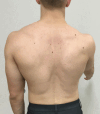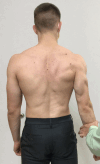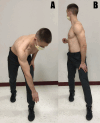Current Views of Scapular Dyskinesis and its Possible Clinical Relevance
- PMID: 35136680
- PMCID: PMC8805107
- DOI: 10.26603/001c.31727
Current Views of Scapular Dyskinesis and its Possible Clinical Relevance
Abstract
Scapular dyskinesis is a condition that is frequently observed clinically but not often understood. Too often it is viewed as a diagnosis which is not accurate because it is a physical impairment. This misclassification of dyskinesis has resulted in literature that simultaneously supports and refutes scapular dyskinesis as a relevant clinical entity as it relates to arm function. These conflicting views have not provided clear recommendations for optimal evaluation and treatment methods. The authors' experience and scholarship related to scapular function and dysfunction support that scapular dyskinesis is an impairment that has causative factors, that a pathoanatomical approach should not be the primary focus but should be considered as part of a comprehensive examination, that a qualitative examination for determining the presence or absence of a scapular contribution to shoulder dysfunction is currently the best option widely available to clinicians, and that rehabilitation approaches should be reconsidered where enhancing motor control becomes the primary focus rather than increasing strength.
Keywords: scapular dyskinesis; shoulder; shoulder rehab.
Figures












Similar articles
-
Clinical implications of scapular dyskinesis in shoulder injury: the 2013 consensus statement from the 'Scapular Summit'.Br J Sports Med. 2013 Sep;47(14):877-85. doi: 10.1136/bjsports-2013-092425. Epub 2013 Apr 11. Br J Sports Med. 2013. PMID: 23580420
-
The Effect of Repeated Shoulder Motion on Scapular Dyskinesis in Army ROTC Cadets.Mil Med. 2020 Jun 8;185(5-6):e811-e817. doi: 10.1093/milmed/usz408. Mil Med. 2020. PMID: 31783408
-
Clinical Diagnosis of Scapular Dyskinesis in a Youth Softball Pitcher: A Case Report.Int J Sports Phys Ther. 2024 Feb 1;19(2):238-244. doi: 10.26603/001c.91642. eCollection 2024. Int J Sports Phys Ther. 2024. PMID: 38313669 Free PMC article.
-
A clinical method for identifying scapular dyskinesis, part 1: reliability.J Athl Train. 2009 Mar-Apr;44(2):160-4. doi: 10.4085/1062-6050-44.2.160. J Athl Train. 2009. PMID: 19295960 Free PMC article.
-
Scapular Dyskinesis: From Basic Science to Ultimate Treatment.Int J Environ Res Public Health. 2020 Apr 24;17(8):2974. doi: 10.3390/ijerph17082974. Int J Environ Res Public Health. 2020. PMID: 32344746 Free PMC article. Review.
Cited by
-
Effects of NMES-Guided Scapular Retraction Exercise Program in Amateur Female Handball Players with Scapular Dyskinesis Without Shoulder Pain: A Randomized Controlled Clinical Trial.J Clin Med. 2025 Aug 7;14(15):5567. doi: 10.3390/jcm14155567. J Clin Med. 2025. PMID: 40807190 Free PMC article.
-
Prevalence and risk factors of non-specific low back pain among amateur overhead athletes in Gauteng Province.S Afr J Sports Med. 2025 May 15;37(1):v37i1a18797. doi: 10.17159/2078-516X/2025/v37i1a18797. eCollection 2025. S Afr J Sports Med. 2025. PMID: 40376105 Free PMC article.
-
Scapular kinematics variability in individuals with and without rotator cuff-related shoulder pain: A systematic review with multilevel meta-regression.Braz J Phys Ther. 2025 Aug 21;29(6):101261. doi: 10.1016/j.bjpt.2025.101261. Online ahead of print. Braz J Phys Ther. 2025. PMID: 40845626 Free PMC article. Review.
-
Functional Restoring in Parsonage-Turner Syndrome With a Multimodal Rehabilitation Program: A Case Report.Cureus. 2025 Mar 11;17(3):e80383. doi: 10.7759/cureus.80383. eCollection 2025 Mar. Cureus. 2025. PMID: 40213747 Free PMC article.
-
Effects of Lumbar Stabilization on Scapular Muscle Activity, Activation Onset Time, and Kinematics in Individuals with Scapular Dyskinesis.J Hum Kinet. 2024 Jul 17;94:23-35. doi: 10.5114/jhk/186972. eCollection 2024 Oct. J Hum Kinet. 2024. PMID: 39563765 Free PMC article.
References
LinkOut - more resources
Full Text Sources
